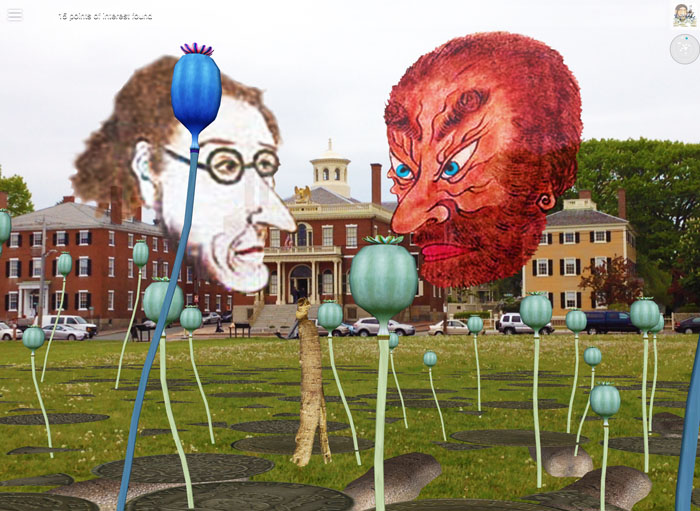Treasures of Seh Rem
Augmented Reality Installation by Tamiko Thiel, 2017Created for "The Augmented Landscape," curated and produced by George Fifield / Boston Cyberarts
With funding from the National Endowment for the Arts (NEA)
May 27 - November 30, 2017, Salem Maritime National Historic Site, Salem, MA.

Long-nosed Americans, depicted by Japanese artists on first contact,
watch over a fever dream of slithering sea cucumbers, ginseng creatures and warped opium poppies
Please also visit the Boston Cyberarts webpage for Treasures of Seh-Rem for my personal backstory! What treasures did the Orient desire from Yankee traders? How did Asians see them, especially on first contact? Treasures of Seh-Rem overlays the greensward of the Salem Maritime Museum with a surreal fever dream of odd, precious wares, under the watchful eyes and hairy visages of Westerners, as depicted by Japanese artists.
This art installation focuses on an idiosyncratic selection of goods that caught my imagination:
- Poppies, from which opium was derived in Turkey and India and smuggled into China (opium was also available prescription free in the USA)
- New England ginseng,
prized as curative and an aphrodisiac in Asia.
- Sea cucumber - Bêche-de-mer - a delicacy in Asia and even now an object of smuggling. (The ones
shown here are called "garlic bread
" sea cucumbers" after their resemblance to same.)
- "Pieces of eight" - the Spanish silver coins of pirate legends, mined in Latin America by enslaved Native Americans. So called because the value of a whole coin was 8 Spanish reales. They were legal tender even when cut into 8ths. (Thence comes the rhyme: "Two bits, four bits, six bits, a dollar ..:"

Treasures of Seh Rem in front of Customs House and other historic buildings on Derby Street

As Jay Dolin describes in his book When America First Met China, western trade with China and the "East Indies" had repercussions long before the Opium Wars. The fur seal trade drove many species to near extinction on the Pacific coast of the Americas, from Alaska down to the Antarctica, and the sandalwood trade caused ecological devastation in Hawaii and Tahiti.